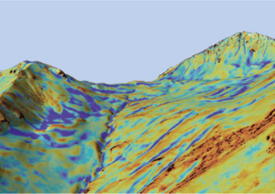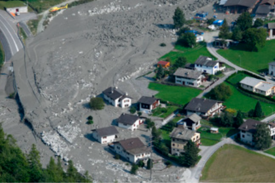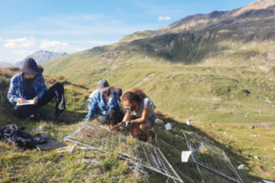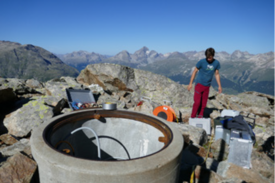
Alpine Environment and Natural Hazards ¶
Head: Dr. Nadine Salzmann
We analyze the impacts of climate change and extreme events on physical and ecological processes and process chains in mountain regions and the associated natural hazards and emerging risks. Our research enables a better understanding of the changing processes, the identification of complex system interactions and thus the early detection and assessment of the most important impacts on the environment and society. The specific thematic focus and core competencies required are formed by the four research groups Permafrost, Mountain Ecosystems, Alpine Remoste Sensing, and Alpine Mass Movements. Inter- and transdisciplinary research with other research units of WSL, national and international research institutions and practice is essential for us.
To achieve our goals, we use a wide range of methods and approaches. These include state-of-the-art sensors (e.g. LiDAR, thermal and multispectral), processing technologies as well as the development of prototypes and specially tailored techniques (e.g. for the analysis of data from satellites, drones and ground-based systems). Long-term monitoring systems (permafrost and biodiversity), and small- to large-scale field experiments (e.g. rockfall in combination with protective forest) form the basis for development of our numerical models developed for science and practice (e.g. RAMMS). To generate plausible scenarios for the future development of the alpine environment, we link our models with climate and extreme weather scenarios from numerical climate and weather models.
Our research unit Alpine Environment and Natural Hazards was formed in July 2021 as part of the establishment of CERC (Climate Change, Extremes and Natural Hazards in Alpine Regions Research Centre) and covers four of CERC's six thematic areas.
Brief insight into our research activities ¶
Recording snow depths using drones ¶
To plan avalanche protection measures and assess their effectiveness, snow depth distribution in high alpine terrain is mapped using drones and aircraft. In collaboration with cantonal and local authorities, we have developed a method that derives the snow depth distribution from the difference between snow-covered and snow-free digital elevation models.
Simulation of rock-ice avalanches ¶
Recent natural disasters such as Pizzo Cengalo (Grisons, Switzerland) or Chamoli (India) have shown how dangerous the transition of rock and ice avalanches into secondary processes such as debris flows can be. We developed a model that considers ice melt, the transition from solid to liquid, and the entrainment of highly saturated rock fall deposits. The model has wide national and international applications, for example in cooperation with SDC, UNDP or UNESCO.
Biodiversity in cold regions under changing climate ¶
Building on our experience with long-term monitoring of changes in plant species in mountain regions, we have expanded this to include more integrative ecosystem research, focusing on animal biodiversity, below- and above-ground interactions, and elevational gradients across tree boundaries. In addition, activities with regional authorities (e.g. investigating 100 years of flora change in Graubünden) have been strengthened.
Long-term observations in permafrost ¶
We maintain a long-term observation network for permafrost in the Swiss Alps as part of the Swiss Permafrost Monitoring Network (PERMOS) and the Global Terrestrial Network for Permafrost (GTN-P). Permafrost characteristics, including ground temperature and rock glacier velocity, are among the Essential Climate Variables (ECV) as defined by the United Nations Framework Convention on Climate Change (UNFCCC).
Research Groups and Staff ¶
Alpine Environment and Natural Hazards
Head of Research Unit |
Alpine Remote Sensing
Group leader |
|
PhD student guest |
|
Scientific staff member |
|
Master student |
|
PhD student |
|
Trainee |
|
Scientific staff member |
|
Scientific staff member |
|
PhD student guest |
|
PhD student |
|
System specialist |
|
Visiting scientist |
|
PhD student |
Alpine Mass Movements
Group leader / Joint Professorship |
|
PhD student |
|
Scientific staff member |
|
PhD student |
|
PhD student |
|
PhD student guest |
|
PhD student |
|
PhD student |
|
PhD student |
|
Administrative staff member |
|
Master student |
|
Scientific staff member |
|
PhD student guest |
|
Visiting scientist |
Mountain Ecosystems
Group leader |
|
PhD student guest |
|
Master student |
|
Master student |
|
PhD student |
|
Scientific staff member |
|
Visiting scientist |
|
Visiting scientist |
|
Master student |
|
Scientific staff member |
|
Temporary employee / Scientific staff member |
|
Visiting scientist |
|
Master student |
|
Master student |
|
Visiting scientist |
|
Postdoc |
|
IT specialist |
|
Technical staff member |
|
Scientific staff member |
|
Master student |
|
Scientific assistant |
|
Scientific staff member |
|
Visiting scientist |
|
Senior Scientist |
|
Master student |
|
Master student |
|
Visiting scientist |
|
PhD student |
Permafrost
Group leader |
|
Scientific staff member |
|
Scientific staff member |
|
PhD student |
|
Scientific staff member |
|
PhD student |
|
Scientific staff member |



